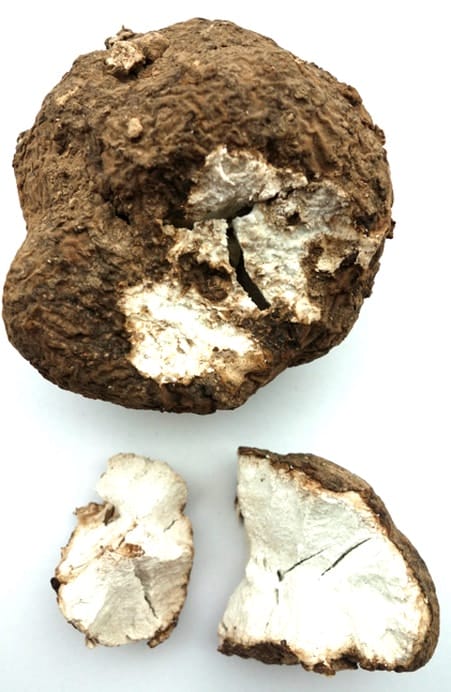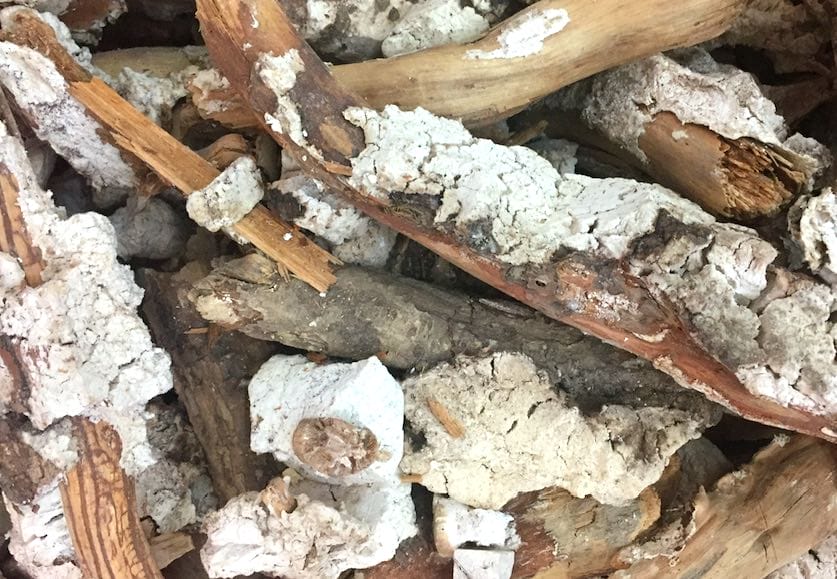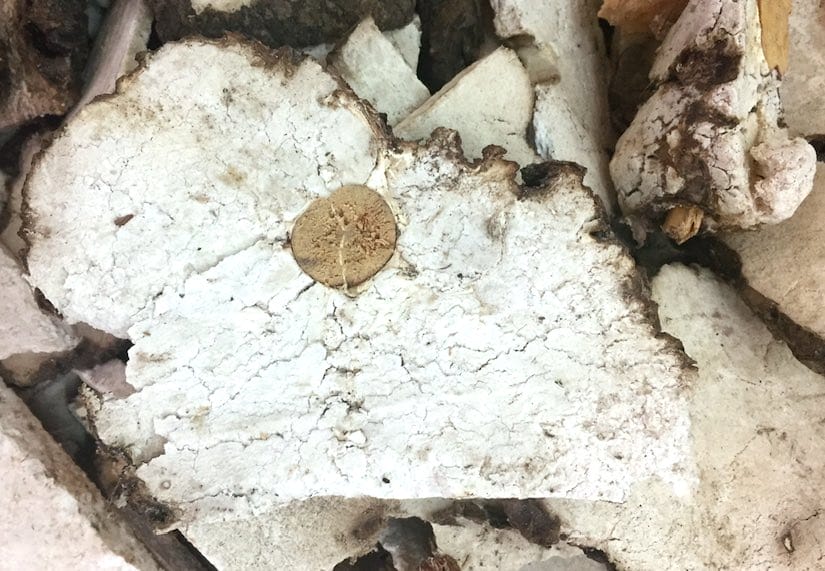Poria, Fu Ling 茯苓
Poria Rubra, Chi Fu Ling 赤茯苓
Poria Cutis, Fu Ling Pi 茯苓皮
Poria Pararadicis, Fu Shen 茯神
Indian Bread, Tuckahoe, Hoelen, PoriaFu Ling (TCM)
Phu Ling (Tibetan)
 A whole, wild Poria root (approx. 25cm across) (Chengdu Medicine Market, Adam, 2016)
A whole, wild Poria root (approx. 25cm across) (Chengdu Medicine Market, Adam, 2016)

|

|
Left: Poria still attached to the root; Right: A slice of Poria with the root running through. (Adam, 2016)
Botanical name:
Poria cocos (syn. Wolfiporia cocos)
Parts used:
Sclerotium; Poria is a subterranean fungus that grows on the roots of Pine trees.
There are 4 main types of Poria are available on the market:
1. Poria
White Poria body, usually in the form of slices, cubes or rolls of the main body of the fungus (without skin or root). This is regarded as more tonifying.
2. Poria Skin (Fu Ling Pi):
This is regarded as a stronger diuretic than Poria, but less strengthening.
3. Root Poria (Fu Shen):
Center of the fungus with the attached root of the tree it is growing on. It is stronger to calm the Mind and Spirit, and settle the Heart. (see photo above)
4. Red Poria (Chi Fu Ling):
The portion of the fungus closer to the skin is purplish-red, and is known as Red Poria (Chi Fu Ling). It clears Heat and Damp and is mainly used for scanty or difficult urination. It is not tonifying and doesn’t settle the Heart.
Temperature & Taste:
Neutral. Sweet-Bland
Classification:
C. Clears Damp, Promotes Urine
Uses:
1. Drains Damp, Promotes Urine:
-an important herb for Damp anywhere in the body
-urinary difficulty, edema, fluid retention
-scanty urination from Damp-heat
-“purges pathological condition in the Urinary Bladder” (Wang Hao Gu)
2. Strengthens the Spleen and Stomach, Benefits Qi:
-fatigue and weakness, poor appetite and indigestion
-diarrhea and loose stool associated with Damp
-“It prolongs one’s lifespan and makes one not feel hungry”. (Shen Nong’s Herbal)
-“tonifies a condition of five overstrains and seven impairments” (Da Ming)
-“By eating the drug, one can live on without eating normal food”. (Tao Hong Jing)
3. Strengthens the Spleen, Resolves Phlegm:
-Phlegm-Damp obstruction with nausea, vomiting, fullness in the chest
-also for Headache, Dizziness and Vertigo from Phlegm-Damp obstruction
4. Calms the Heart and Spirit:
-palpitations, insomnia, amnesia caused by Damp-Phlegm.
-“relieves melancholy, anger, fright and terror” (Shen Nong’s Herbal)
-“Long-term use pacifies the soul and nourishes the Spirit”. (Shen Nong’s Herbal)
-“improves Intelligence and enlightens Wisdom” (Da Ming)
-“Helps one to sleep well” (Ming Yi Bie Lu)
-“also good for treating infantile Convulsion and Epilepsy” (Zhen Quan)
Dose:
Decoction: 6–15 grams;
Powder: 2–5 grams
Substitute:
1. Polyporus Zhu Ling is considered very similar in effect. It lacks the tonic properties of Poria Fu Ling, but is more effective an a diuretic..
2. Phlomis tuberosa is used as a substitute for Poria Fu Ling in Tibetan Medicine.
3. For thick Phlegm and Phlegm and Damp Masses and Tumors, Agaric (Fomitopsis officinalis) may be used and is more effective.
Preparation:
Traditionally, Poria Fu Ling was prepared with Cinnabar to increase the effect of calming the mind and spirit. Because of the potential toxicity of Cinnabar, this is rarely used in modern China and is not appropriate for use in the West.
Main Combinations:
Poria Fu Ling and Pinellia Ban Xia
Poria Fu Ling is often combined with Pinellia Ban Xia. Poria is better for thin Damp and strengthens the Spleen while Pinellia is better for thick Phlegm. When combined, they form a powerful combination for all Cold-Phlegm-Damp conditions. This is the flag-ship formula for these conditions in TCM, and when combined with Tangerine/Orange peel (Ju Hong/Chen Pi) and Licorice root, it forms Er Chen Tang [Two-Cured Decoction]).
1. Nausea and vomiting from Cold-Damp-Phlegm, Poria Fu Ling with Pinellia Ban Xia and fresh Ginger
2. To promote urine and clear Damp:
i. Poria Fu Ling with Water Plantain root (Alisma Ze Xie).
ii. Poria Fu Ling with Polyporus Zhu Ling
iii. Poria Fu Ling with Water Plantain root (Alisma Ze Xie)., Polyporus Zhu Ling , Cinnamon twig (Gui Zhi) and Atracylodes Bai Zhu (this is Wu Ling San)
3. Edema from Kidney Yang deficiency (marked Coldness),
i. Poria Fu Ling, Cinnamon (Rou Gui), Atractylodes Bai Zhu
ii. Poria Fu Ling with Atractylodes Bai Zhu and Aconitum Fu Zi (as in Zhen Wu Tang [True Warrior Decoction)
4. For Internal Dampness with a sense of heaviness, lethargy and scanty or painful urine, Poria Fu Ling with Cinnamon twig Gui Zhi and Atractylodes Bai Zhu.
5. Burning Urine, Swelling in the pelvis, dysuria, strong colored urine, Poria Fu Ling, Water Plantain root (Alisma Ze Xie). Phellodendron Huang Bai, Anemarrhena Zhi Mu. (Li Gao)
5. For fatigue and weakness, poor appetite, loose stool and indigestion, Poria Fu Ling with Ginseng (or Codonopsis Dang Shen), Atractylodes Bai Zhu, Fried Licorice (Zhi Gan Cao) (as in Si Jun Zi Tang)
6. Abdominal distention from overeating and overdrinking: powder equal parts of Poria Fu Ling and Evodia Wu Zhu Yu. Form honey pills the size of a parasol seed. Take 50 as a dose. (Ben Cao Gang Mu)
6. Diarrhea from excess Damp:
i. Poria Fu Ling with Costus
ii. Poria Fu Ling with Atractylodes Bai Zhu, Saposhnikovia Fang Feng
iii. Poria Fu Ling with Chebula, Red Earth
7. Obesity, Poria Fu Ling, Cyperus Xiang Fu, Citrus unshiu peel (Wen Zhou Mi Ju)
8. Palpitation and shortness of breath from Heart deficiency, Poria Fu Ling with Licorice and Cinnamon
9. Palpitations, Insomnia, Restlessness, poor Memory, Poria Fu Ling with Calamus (Shi Chang Pu)
10. Treatment of the Elderly:
i. Cognitive impairment in the elderly, Poria Fu Ling with Ginseng and Polygala Yuan Zhi
ii. Poria Fu Ling with Aloeswood (Chen Xiang), Rehmannia Shu Di Huang, Lycium Gou Qi Zi, Ginseng.
iii. Heart weakness in the elderly, Poria Fu Ling, Ganoderma Ling Zhi
11. Depression, Anxiety:
i. Poria Fu Ling with Cordyceps.
ii. Poria Fu Ling with Atractylodes Bai Zhu, Paeonia Bai Shao, Dang Gui, Bupleurum Chai Hu, Mint (Bo He), fresh Ginger, honey-fried Licorice (Zhi Gan Cao) (as in Xiao Yao San)
12. Cancer:
i. Pancreatic, Poria Fu Ling with Scutellaria Huang Qin, Codonopsis Dang Shen, Atractylodes Bai Zhu, Coix Yi Yi Ren, Dang Gui, Citrus peel, Artemisia Yin Chen Hao, Polyporus Zhu Ling, Agrimony (Xian He Cao), Smilax Tu Fu Ling, Hedyotis Bai Hua She She Cao. (This was listed in a research case)
Major Formula:
Ban Xia Bai Zhu Tian Ma Tang
Ban Xia Hou Po Tang
Bao He Wan
Ding Xian Wan
Ding Zhi Wan
Er Chen Tang
Fu Ling Gui Zhi Gan Cao Da Zao Tang
Gui Zhi Fu Ling Wan
Ling Gan Wu Wei Jiang Xin Tang
Liu Jun Zi Tang
Liu Wei Di Huang Wan
Er Long Zuo Ci Wan
Gou Teng San
Ma Wei Di Huang Wan
Ming Mu Di Huang Wan
Mu Xiang Shun Qi Wan
Qi Ju Di Huang Wan
Zhi Bai Di Huang Wan
Shen Ling Bai Zhu San
Shen Qi Wan
Shi Quan Da Bu Tang
Si Jun Zi Tang
Wu Ling San
Wu Pi San
Xiao Yao San
Cautions:
Generally Safe.
1. Avoid in marked Yin deficiency unless corrected (as in Liu Wei Di Huang Wan)
2. Older TCM texts said it should not be used in dribbling urine or incontinence from Kidney weakness, or urinary difficulty from Yin deficiency.
